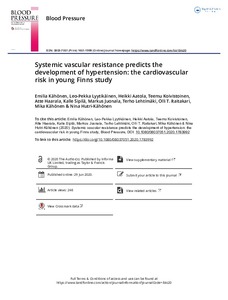Systemic vascular resistance predicts the development of hypertension: the cardiovascular risk in young Finns study
Emilia Kähönen; Leo-Pekka Lyytikäinen; Heikki Aatola; Teemu Koivistoinen; Atte Haarala; Kalle Sipilä; Markus Juonala; Terho Lehtimäki; Olli T. Raitakari; Mika Kähönen; Nina Hutri-Kähönen
Systemic vascular resistance predicts the development of hypertension: the cardiovascular risk in young Finns study
Emilia Kähönen
Leo-Pekka Lyytikäinen
Heikki Aatola
Teemu Koivistoinen
Atte Haarala
Kalle Sipilä
Markus Juonala
Terho Lehtimäki
Olli T. Raitakari
Mika Kähönen
Nina Hutri-Kähönen
TAYLOR & FRANCIS LTD
Julkaisun pysyvä osoite on:
https://urn.fi/URN:NBN:fi-fe2021042822154
https://urn.fi/URN:NBN:fi-fe2021042822154
Tiivistelmä
Purpose: To study whether systemic hemodynamics, especially systemic vascular resistance, predicts the development of hypertension and improves the risk prediction of incident hypertension beyond common risk factors in the risk models in young adults.
Materials and methods: Typical risk factors for hypertension in the risk prediction models (systolic and diastolic blood pressure, parental history of hypertension, age, sex, body-mass index, smoking), laboratory values (high-density lipoprotein cholesterol, low-density lipoprotein cholesterol, triglycerides, glucose, insulin, C-reactive protein), heart rate (HR), stroke index (SI), and systemic vascular resistance index (SVRI) calculated by whole-body impedance cardiography were evaluated in 2007 and blood pressure in 2011 in 1293 Finnish adults (aged 30-45 years; females 56%;n = 1058 normotensive in 2007).
Results: Of hemodynamic variables, SVRI and HR evaluated in 2007 were independently associated with systolic blood pressure (p < 0.001 andp = 0.047, respectively) and SVRI with diastolic blood pressure measured in 2011 (p = 0.014), and SVRI and HR were independent predictors of incident hypertension (p < 0.001 andp = 0.024, respectively). SVRI was the most significant predictor of incident hypertension independently of other risk factors (odds ratio 2.73 per 1 standard deviation increase, 95% confidence interval 1.93-3.94,p < 0.001). The extended prediction model (including SVRI) improved the incident hypertension risk prediction beyond other risk factors, with an area under the receiver operating characteristic curve of 0.846 versus 0.817 (p = 0.042) and a continuous net reclassification improvement of 0.734 (p < 0.001).
Conclusions: These findings suggest that systemic vascular resistance index predicts the incidence of hypertension in young adults and that the evaluation of systemic hemodynamics could provide an additional tool for hypertension risk prediction.
Kokoelmat
- Rinnakkaistallenteet [27094]
